
In baseball statistics, a hit, also called a base hit, is credited to a batter when the batter safely reaches or passes first base after hitting the ball into fair territory with neither the benefit of an error nor a fielder's choice.
In baseball, a sacrifice fly is defined by Rule 9.08(d): "Score a sacrifice fly when, before two are out, the batter hits a ball in flight handled by an outfielder or an infielder running in the outfield in fair or foul territory that
- is caught, and a run scores after the catch, or
- is dropped, and a runner scores, if in the scorer's judgment the runner could have scored after the catch had the fly ball been caught."
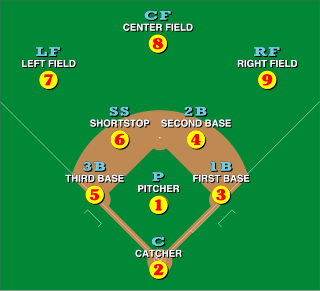
In the sport of baseball, each of the nine players on a team is assigned a particular fielding position when it is their turn to play defense. Each position conventionally has an associated number, for use in scorekeeping by the official scorer: 1 (pitcher), 2 (catcher), 3, 4, 5, 6 (shortstop), 7, 8, and 9. Collectively, these positions are usually grouped into three groups: the outfield, the infield, and the battery. Traditionally, players within each group will often be more able to exchange positions easily ; however, the pitcher and catcher are highly specialized positions and rarely will play at other positions.

Softball is a popular variation of baseball, the difference being that it is played with a larger ball on a smaller field and with only underhand pitches permitted. Softball is played competitively at club levels, the college level, and the professional level. The game was first created in 1887 in Chicago by George Hancock.
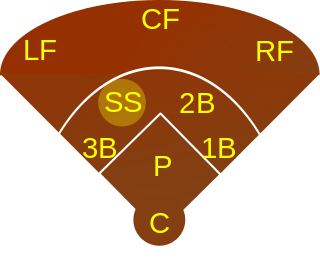
Shortstop, abbreviated SS, is the baseball or softball fielding position between second and third base, which is considered to be among the most demanding defensive positions. Historically, the position was assigned to defensive specialists who were typically poor at batting and were often placed at the bottom of the batting order. Today, shortstops are often able to hit well and many are placed at the top of the lineup. In the numbering system used by scorers to record defensive plays, the shortstop is assigned the number 6.
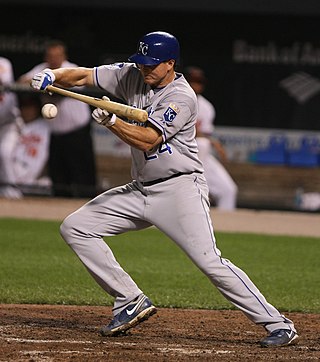
A bunt is a batting technique in baseball or fastpitch softball. Official Baseball Rules define a bunt as follows: "A bunt is a batted ball not swung at, but intentionally met with the bat and tapped slowly within the infield." To bunt, the batter loosely holds the bat in front of home plate and intentionally taps the ball into play. A properly executed bunt will create weak contact with the ball and/or strategically direct it, forcing the infielders to make a difficult defensive play to record an out.
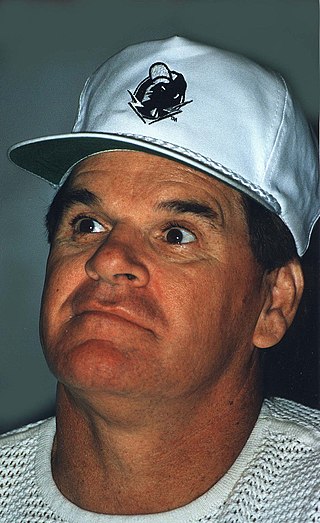
In baseball, a single is the most common type of base hit, accomplished through the act of a batter safely reaching first base by hitting a fair ball and getting to first base before a fielder puts him out. As an exception, a batter-runner reaching first base safely is not credited with a single when an infielder attempts to put out another runner on the first play; this is one type of a fielder's choice. Also, a batter-runner reaching first base on a play due to a fielder's error trying to put him out at first base or another runner out is not credited with a single.

The infield fly rule is a rule of baseball and softball that treats certain fly balls as though caught, before the ball is caught, even if the infielder fails to catch it or drops it on purpose. The umpire's declaration of an infield fly means that the batter is out regardless of whether the ball is caught. The rule exists solely to prevent the defense from executing a double play or triple play by deliberately failing to catch a ball that an infielder could catch with ordinary effort.

A first baseman, abbreviated 1B, is the player on a baseball or softball team who fields the area nearest first base, the first of four bases a baserunner must touch in succession to score a run. The first baseman is responsible for the majority of plays made at that base. In the numbering system used to record defensive plays, the first baseman is assigned the number 3.
An infielder is a baseball player stationed at one of four defensive "infield" positions on the baseball field, between first base and third base.
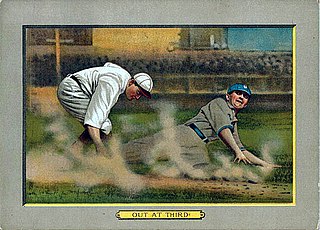
In baseball, an out occurs when the umpire rules a batter or baserunner out. When a batter or runner is out, they lose their ability to score a run and must return to the dugout until their next turn at bat. When three outs are recorded in a half-inning, the batting team's turn expires.
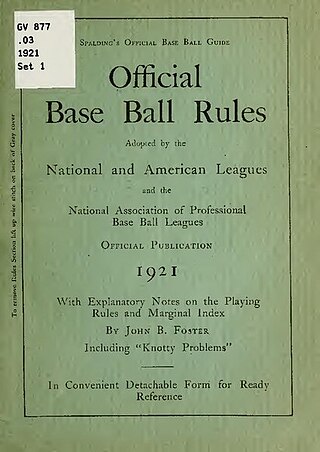
Throughout the history of baseball, the rules have frequently changed as the game continues to evolve. A few common rules most professional leagues have in common is that four balls is a base on balls, three strikes is a strikeout, and three outs end a half-inning.
In baseball, interference occurs in situations in which a person illegally changes the course of play from what is expected. Interference might be committed by players on the offense, players not currently in the game, catchers, umpires, or spectators. Each type of interference is covered differently by the rules.

Pesäpallo is a fast-moving bat-and-ball sport that is often referred to as the national sport of Finland and has some presence in other places including Germany, Sweden, Switzerland, Australia, and Canada's northern Ontario. It is similar to brännboll, rounders, lapta, and baseball.
A hit and run is a high risk, high reward offensive strategy used in baseball. It uses a stolen base attempt to try to place the defending infielders out of position for an attempted base hit.
This is an alphabetical list of selected unofficial and specialized terms, phrases, and other jargon used in baseball, along with their definitions, including illustrative examples for many entries.
Slap bunting is an offensive baseball and softball technique wherein the batter attempts "to hit the ball to a place on the infield that's farthest from the place where the out needs to be made".
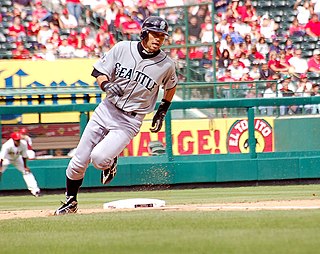
In baseball, base running is the act of running from base to base, performed by members of the team at bat.
A fifth infielder is the rare instance in baseball when a team may elect to bring in an outfielder to play the infield. This is usually done when the game is tied in the bottom of the ninth or an extra inning, the home team has a runner at 3rd base with fewer than two outs. Normally with a runner on 3rd with less than two outs, a manager will usually have the infield playing in, as to cut down a runner trying to score. Bringing the infield in is a typical strategy used late in games, when a potential tying, go-ahead, winning or crucial insurance run is at 3rd base with less than two outs. In cases like this, if a ball is hit right to an infielder, the infielder usually has a chance to throw out the runner trying to score. However, any ground ball not hit at an infielder will usually have a good chance to score the runner, plus the batter reaching base safely, versus if the infield plays back. When the infield plays back, it does make it more likely for the run to score, but the infielders are more likely to get the batter out via a ground out.











